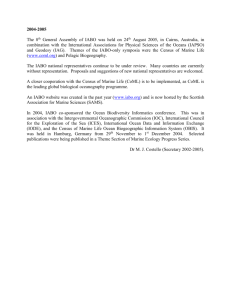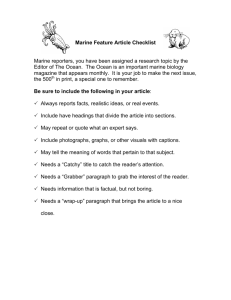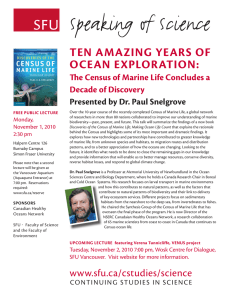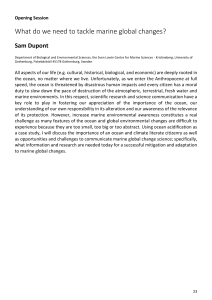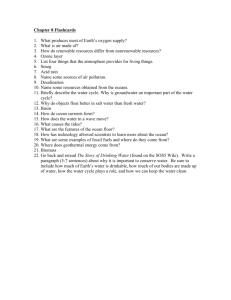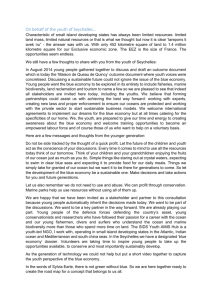2 0 0 5 CENSUS OF MARINE LIFE JANUARY APRIL
advertisement
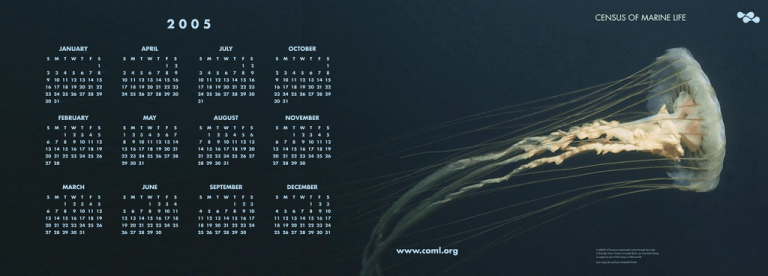
CENSUS OF MARINE LIFE 2005 JANUARY S M T W T APRIL F S S M T W T 1 2 9 3 4 5 6 7 8 3 4 5 6 7 JULY F S 1 2 8 9 S 3 M 4 T 5 W 6 OCTOBER T 7 F S S 1 2 8 9 2 9 M T W T F S 1 3 4 5 6 7 8 10 11 12 13 14 15 10 11 12 13 14 15 16 10 11 12 13 14 15 16 16 17 18 19 20 21 22 17 18 19 20 21 22 23 17 18 19 20 21 22 23 16 17 18 19 20 21 22 23 24 25 26 27 28 29 24 25 26 27 28 29 30 24 25 26 27 28 29 30 23 24 25 26 27 28 29 31 30 31 30 31 FEBRUARY S 6 M 7 MAY AUGUST T W T F S S M T W T F S 1 2 3 4 5 1 2 3 4 5 6 7 8 9 10 11 12 8 9 10 11 12 13 14 S 7 10 11 12 13 14 15 NOVEMBER M T W T F S 1 2 3 4 5 6 8 9 10 11 12 13 S 6 M 7 T W T F S 1 2 3 4 5 8 9 10 11 12 13 14 15 16 17 18 19 15 16 17 18 19 20 21 14 15 16 17 18 19 20 13 14 15 16 17 18 19 20 21 22 23 24 25 26 22 23 24 25 26 27 28 21 22 23 24 25 26 27 20 21 22 23 24 25 26 27 28 29 30 31 28 29 30 31 27 28 29 30 MARCH S 6 M 7 JUNE T W T F S 1 2 3 4 5 8 9 10 11 12 S 5 M 6 T 7 SEPTEMBER W T F S 1 2 3 4 8 9 10 11 S 4 M 5 T 6 W 7 DECEMBER T F S 1 2 3 8 9 10 S 4 M 5 T 6 W 7 T F S 1 2 3 8 9 10 13 14 15 16 17 18 19 12 13 14 15 16 17 18 11 12 13 14 15 16 17 11 12 13 14 15 16 17 20 21 22 23 24 25 26 19 20 21 22 23 24 25 18 19 20 21 22 23 24 18 19 20 21 22 23 24 27 28 29 30 31 26 27 28 29 30 25 26 27 28 29 30 25 26 27 28 29 30 31 www.coml.org A jellyfish (Chrysaora melanaster) moves through the water In the high Arctic Ocean’s Canada Basin, an area that’s being surveyed as part of the Census of Marine Life Russ Hopcroft and Kevin Raskoff/NOAA www.coml.org CENSUS OF MARINE LIFE | 2004 HIGHLIGHTS MAKING OCEAN LIFE COUNT CENSUS OF MARINE LIFE Hundreds of scientists around the world are contributing to the Census of Marine Life (CoML), the first comprehensive portrait of life in the world’s oceans—past, present, and future. Launched in 2000 and running through 2010, the Census embraces researchers and institutions from more than 70 countries, pooling skills and tools to assess the diversity, distribution, and abundance of ocean life over time. In 2004, the Census grew to 13 projects (acronyms in parentheses), detailed at the Census of Marine Life Web Portal www.coml.org. Census researchers organize their work in two ways, according to kinds of life and geography. Scientists are studying everything from large ocean predators to the tiniest microbes in ocean realms ranging from shallow coastal waters to the deep sea. Field projects track migrations to map distributions, for example, of salmon and sturgeon along North America’s west coast (POST) and of turtles and tuna transiting the Pacific (TOPP). Data on the genes of microbes (ICoMM) and zooplankton (CMarZ) support a complementary project, creation of universal standards to aid quick, accurate identification of species. Census researchers study biodiversity along nearshore areas from equatorial to polar water (NaGISA) and around a vast seafloor mountain range, the Mid-Atlantic Ridge (MAR-ECO). Using sophisticated robot submersibles and cameras, investigations plunge to depths of 6000 meters along the abyssal plains of the sea floor (CeDAMar) and near vents and seeps (ChEss) where chemical energy, rather than sunlight, sustains life. Teams survey the sea life and habitats of a classic, exploited regional ecosystem, the Gulf of Maine (GoMA), to refine ecosystem-based ocean management, and visit the unexplored Arctic (ArcOD) to assemble baseline data that might later show changes associated with global warming. To achieve the goal of sampling all major forms of marine life and ocean realms, the Census field program will soon expand to seamounts, coral reefs, and continental margins, as well as the Antarctic and Southern Ocean. Observers feed project data into a burgeoning online database (OBIS) that makes information about marine life accessible to researchers, managers, and students anytime, anywhere. Already online are more than five million records, documenting almost 40,000 species, complete with tools for making maps and relating the presence of animals to currents, temperature, and other ocean conditions. Contributors added more than three million records to this database in 2004 alone. To complement ongoing fieldwork, Census researchers are compiling data on marine animal populations from the past 500 or so years (HMAP) and developing predictive models to help foresee life in the world’s oceans of tomorrow (FMAP). Exploring the Unknown Humans have explored less than five percent of the world’s oceans, and even where we have explored, life may have been too small to see. Thus, opportunities abound to discover species and increase our knowledge of abundance and distribution. Advances in technology lift limits for discovery of life that is small, deep, or rare. CANADA BASIN ArcOD: Crustacean zooplankton Cyclocaris guilelmi. Photo: R. Hopcroft/NOAA ICoMM: Single-celled eukaryotic microbe (~2mm in diameter). Photo: L. Amaral Zettler Microbes, the smallest organisms, astonishingly form more than 90 percent of biomass in the ocean. Census researchers are building a cyber-infrastructure to organize what is known about this huge micro-world and prepare for countless new arrivals. NaGISA: Photo: S. Bussarawit CeDAMar: ANDEEP. Photo: W. Broekelandt ArcOD: Canada Basin. NOAA, Ocean Exploration The manned submersible, Nautile, carries investigators to deep-sea hydrothermal vents to observe the biodiversity of this unique habitat and collect samples with its robotic arm. New protocols for the inventory of nearshore coastal biodiversity enable comparative worldwide surveys. Above, researchers sort samples of organisms in Thailand. Researchers used a redesigned device, the epibenthic sledge, to collect specimens down to 6000 meters below the surface in the delicate habitats of Africa’s Angola Basin, and explored the benthos of the deep Southern Ocean, one of Earth’s least-known marine areas. The samples revealed surprising patterns of deep species and endemism markedly different from one animal group to another. Modern sonar detection, remotely operated vehicles, and traditional techniques catalog Arctic Ocean species, some isolated for tens of millions of years. One area under investigation is the Arctic’s Canada Basin, an icelidded bowl containing some of the oldest water in the world. In this virtually unexplored ocean realm, we know many unusual creatures await discovery. The remotely-operated vehicle, Isis, withstands crushing pressures and extreme temperatures to study the geology, geochemistry, and biology of hydrothermal vents and cold seeps. ChEss: Photo: D. Edge, Southampton Oceanography Centre Fifty scientists from eight countries tagging 22 species of open-ocean animals in the North Pacific are allying with the animals to create the first-ever map of marine life highways and hot spots. More than 1500 “animal observers” now carry compact electronic tags, some recording data for future retrieval, others revealing animal movements across the Pacific in near real time. Scientists have observed the transoceanic journeys of tuna from Mexico to Japan, followed salmon sharks on two-year migrations from Alaska to Hawaii, and tracked endangered leatherback sea turtles as they fanned out from their nesting beaches in Costa Rica. The animals provide valuable insights along the way into their behavior (depth preferences, for example) and about ocean conditions. Integrating Data, Creating Information Census scientists are innovating, refining, and integrating techniques to assess and monitor marine life. For example, newly field-tested equipment and techniques reveal hundreds of new microbial life forms quickly and inexpensively through sophisticated filtration and gene sequencing. ChEss: Photo: D. Desbruyères, PHARE-Ifremer Seeing the Ocean as Its Inhabitants Do ArcOD: Narcomedusa, a potentially new species of jellyfish. Photo: K. Raskoff MAR-ECO: Potential new species of anglerfish of the genus Lophodolus. Photo: T. Sutton TOPP: Salmon shark migration is in pink; elephant seal, black; blue shark, green; and mako shark, red. Understanding the movements of the ocean’s top predators helps identify critical habitat areas and migratory corridors, information useful to better manage marine resources. Census researchers have created a database of more than 6800 species of zooplankton, animals that drift with the currents. They expect to discover, identify, and add at least as many zooplankton species to the database over the next six years. Crossed largely without notice by countless vessels for the past 1000 years, the Mid-Atlantic Ridge is a submerged mountain range dividing the North American and Eurasian plates. It may prove a popular waystation for trans-Atlantic submarine animal travelers, and home for species that surface sailors never see. After two months aboard Norway’s state-ofthe-art research vessel G.O. Sars, 60 scientists from 13 countries returned with unprecedented quantity and quality of video footage captured by robot submersibles, sonar data showing deep donuts of plankton ten kilometers in diameter, and photographs of many probable new species among 80,000 specimens collected. POST: A salmon is fitted with an acoustic tag. Photo: D. Welch POST: An acoustic array on the Pacific Ocean sea floor is shown in red. Acoustic tags in young salmon allow listening lines on the floor of the Pacific Ocean to record their location from Washington State along the coast of British Columbia to southeast Alaska. The tracking array’s listening lines picked up tagged green sturgeon from northern California, rarest of the 26 sturgeon species, having traveled 1000 kilometers north to Canada’s Brook’s Peninsula. The finding may prompt new protection strategies for this endangered fish, known to spawn only in a few western U.S. rivers. OBIS: Red dots represent areas where Census data were collected on a quarter of the 200,000 known marine species. We have barely skimmed the surface. The Census database will eventually contain records on potentially millions of new species yet to be identified. Analysis of the current five million database records reveals that near-surface records account for 95 percent of observations of ocean life; less than 0.1 percent are from the bottom half of the water column. A specimen collected below 2000 meters could be 50 times more likely to be new to science than one found at 50 meters. Sharing the Knowledge Discovering Past and Present Populations To make the findings of Census scientists more accessible and to share the excitement of the technology that makes the dream of a Census a reality, team members launched the educational website Investigating Marine Life at www.coml.org. The Census is a unique opportunity to document and understand changes in what lives below the water’s surface by studying historical fisheries records, comparing these to present populations, and using this information to predict future population trends. By sampling remote and previously unexplored ocean regions, scientists discover new species and chart the potential of identifying many more. A selection of 2004 discoveries follows: MAR-ECO: Track and stations of Leg 1 of the RV G.O. Sars expedition, 5 June–3 July 2004. CMarZ: Zooplankton of the genus Tomopteris. Photo: R. Hopcroft/NOAA ArcOD: Copepod Euchaeta barbata. Photo: R. Hopcroft/NOAA MAR-ECO: Deep sea jellyfish of the genus Atolla (above left). Photo: D. Shale. Newly discovered squid of the genus Promachoteuthis (above right). Photo: R. Young A new super-portal is serving as a model for ecosystembased marine management worldwide. Layers of biological, physical, chemical, and geologic data from the Gulf of Maine are merged online in unprecedented ways. Through a partnership among ocean observers of many kinds, the super-portal permits, for example, combining trends in ground fisheries with records on the presence of prey, temperature, currents, and sea floor topography, improving understanding of species behavior and suggesting better ecosystem-based management policies. TOPP: A scientist tags a salmon shark fin. Photo courtesy of R. Kochevar. Documenting the Known GoMA: Researchers sort specimens from a Gulf of Maine trawl. Photo courtesy of M. Vecchione HMAP: This mid-19th century illustration depicts fishermen using single hand lines from inside the rail, as was the practice during the colonial era. HMAP: Tub trawling from dories replaced handlining in the latter half of the 19th century. As fishing technology changed in the 19th century, the size of landed cod decreased significantly. Large cod caught in the 1600s could weigh as much as 80 pounds. New England fishermen employed one or two handlines over the rail of small vessels until the 1850s, still occasionally catching very large fish. In the 1860s, the new technique of tub trawling replaced handlining, increasing by hundreds the number of hooks each man could fish. More fish were caught, but fishing was less selective; cod weighed, on average, 30 percent less. ChEss: A rich variety of fauna lie near a hydrothermal vent in the Indian Ocean. FMAP: Oceanic whitetip shark, Carcharhinus longimanus. Photo: S. Jones, www.millionfish.com CeDAMar: CeDAMar CeDAM ar:: An unknown octopod possibly of the ar genus Pareledone. Photo: L. Alcock NaGISA: Rhodoliths, coral-like algae, resemble toy jacks. Photo: K. Iken Comparison of historical and current data showed that the population of oceanic whitetip sharks in the Gulf of Mexico has dropped 99 percent since the mid-1950s. The loss of these sharks and other predators caused an explosion of corresponding magnitude in the population of pelagic stingrays. A recent decline of sharks in the Northwest Atlantic also was measured, ranging from 40 percent among makos to almost 90 percent for hammerheads. Many fauna of the Antarctic shelf are highly endemic. For example, about 85 percent of deepsea crustaceans found there are unique to that region. However, the deep Southern Ocean harbors many single-cell species known from the North Atlantic and elsewhere. The deep Southern Ocean also yielded a surprisingly large collection of octopods—four species in two genera, including one genus new to science. Discovery of a colony of rhodoliths, coral-like marine algae, surprised biologists studying Prince William Sound, Alaska. Hard and red, resembling toy jacks, the plants roll like tumbleweed in beds used as nurseries by scallops, shrimp, and other invertebrates, prompting plans to study the plants’ contribution to the ecosystem. Hydrothermal vent communities around the globe continued to offer large and small additions to the book of life. A suspected new species of clam that draws life from methane hydrates was documented off the coast of Chile, while a new species of minute mollusk was discovered in vents in the Indian Ocean.
